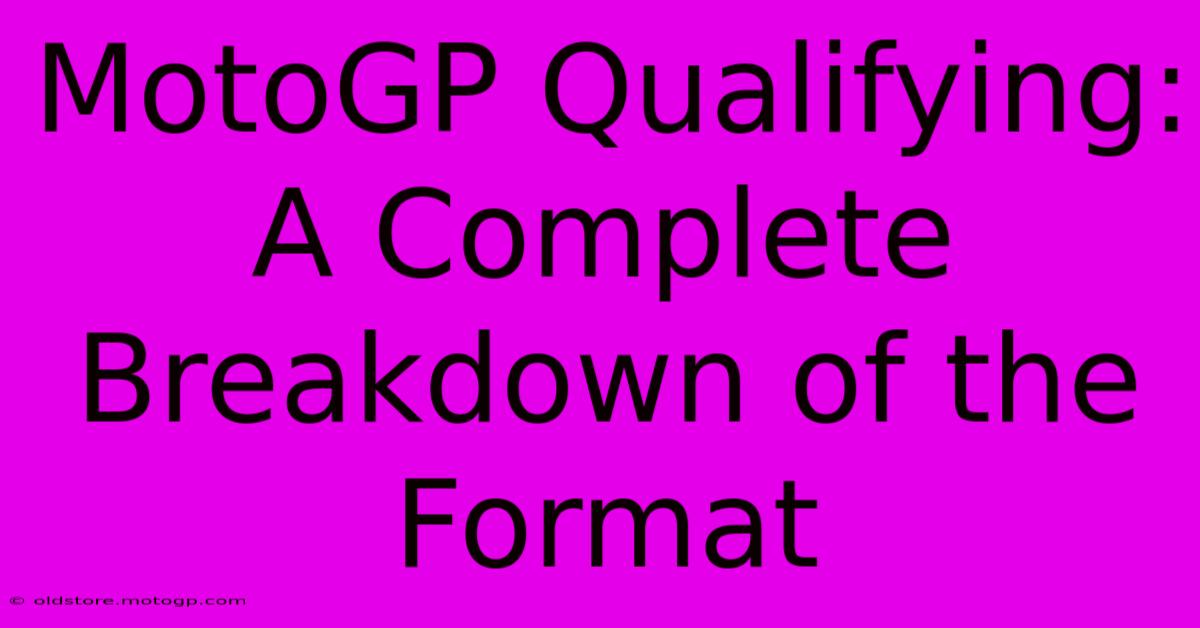MotoGP Qualifying: A Complete Breakdown Of The Format

Table of Contents
MotoGP Qualifying: A Complete Breakdown of the Format
MotoGP qualifying is a crucial part of the weekend, determining the starting grid for the race. Understanding the format is key to appreciating the drama and strategy involved. This comprehensive guide breaks down the process, explaining each session and highlighting the nuances that make it so compelling.
The Qualifying Structure: A Three-Session Showdown
MotoGP qualifying isn't a single sprint; it's a multi-stage process designed to separate the fastest riders from the pack. It comprises three sessions:
1. Qualifying 1 (Q1): The Fight for Q2
Q1 sets the stage for the main event. The riders who finished outside the top 10 in the combined Free Practice times (FP1, FP2, and FP3) compete in this 15-minute session. Only the two fastest riders from Q1 progress to Q2. This session is often characterized by intense battles and high stakes, as riders fight for precious grid positions. The pressure is immense; a small mistake can mean the difference between a front-row start and a mid-pack struggle.
Key Considerations in Q1:
- Tire Management: Riders need to balance pushing for a fast lap with preserving their tires for the race. A worn tire can significantly impact lap times.
- Track Conditions: Understanding how the track evolves throughout the session is crucial. Finding the optimal grip and tire temperature is key.
- Slipstream: Drafting behind another rider can provide a significant speed boost, making strategic positioning vital.
2. Qualifying 2 (Q2): The Battle for Pole Position
The top 10 riders from the combined Free Practice sessions automatically qualify for Q2. Joined by the two fastest riders from Q1, they battle it out for the coveted pole position and the best starting spots on the grid. This 15-minute session is usually even more intense, with riders pushing their machines and their skills to the absolute limit.
Key Considerations in Q2:
- One-Lap Pace: Q2 is primarily focused on achieving the fastest possible single lap, unlike the race, which demands consistent pace.
- Tire Choice: Selecting the right tire compound for a single fast lap is vital. The wrong choice can ruin a potential pole position.
- Strategic Laps: Riders often strategically plan their laps, utilizing slipstreaming and saving tires for their final, crucial attempt.
3. The Importance of Free Practice (FP1, FP2, and FP3)
Before the qualifying sessions even begin, Free Practice plays a vital role. FP1, FP2, and FP3 are crucial for riders to understand their machines, test different setup options, and gather data on tire performance and track conditions. The combined times from these sessions determine which riders start in Q1 and which progress directly to Q2. In essence, Free Practice lays the groundwork for success in qualifying.
Mastering the Art of MotoGP Qualifying
Success in MotoGP qualifying demands more than just speed. It requires a deep understanding of:
- Bike Setup: Fine-tuning the motorcycle's setup for optimal performance on the specific track is critical.
- Tire Strategy: Choosing the right tires for each session and managing tire wear is paramount.
- Racecraft: Strategic maneuvers, like slipstreaming and finding clear track space, are crucial for maximizing lap times.
- Track Knowledge: A detailed understanding of the track's intricacies, including braking points, cornering lines, and optimal racing lines, is essential.
The Impact of Qualifying on the Race
The starting grid position significantly impacts the race outcome. A front-row start provides a considerable advantage, offering a clear track ahead and opportunities for early race control. This is especially crucial in MotoGP races where overtaking is often challenging. Conversely, starting from further back increases the difficulty of securing a podium finish.
In conclusion, MotoGP qualifying is a complex and thrilling spectacle that demands skill, strategy, and a dash of luck. Understanding the format and the factors at play allows for a deeper appreciation of the intensity and significance of this crucial stage of the MotoGP weekend.

Thank you for visiting our website wich cover about MotoGP Qualifying: A Complete Breakdown Of The Format. We hope the information provided has been useful to you. Feel free to contact us if you have any questions or need further assistance. See you next time and dont miss to bookmark.
Featured Posts
-
Cota F1 Merch Because You Re A True Fan
Feb 23, 2025
-
Your Worry Free Ride To The Grand Prix F1 Shuttles
Feb 23, 2025
-
Upgrade To Extraordinary Ex Factory Race Bikes
Feb 23, 2025
-
Cota Concerts The Best Shows Under The Texas Sky
Feb 23, 2025
-
Moto Gp Starting Grid The Ultimate Grid Guide For 2024
Feb 23, 2025
